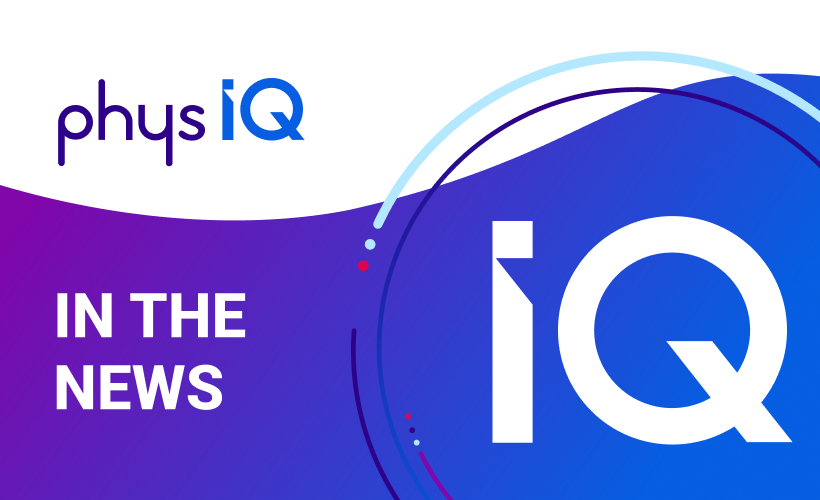Inside an Individual’s Physiological Signature
Originally published in Medical Device & Technology
3 min read
![]() physIQ
:
July 30, 2019
physIQ
:
July 30, 2019

Originally published in MobiHealthNews
physIQ has received 510(k) clearance for an algorithm facilitating cloud-based analysis of patients’ continuous ambulatory respiration rates, according to an update to the FDA’s device clearance database that was confirmed by the company to MobiHealthNews.
This regulatory clearance is the company’s third, and like its predecessors uses artificial intelligence to characterize raw sensor data as actionable vital signs readings.
WHY IT MATTERS
physIQ’s algorithms are capable of extracting these raw readings from a variety of monitoring hardware, and then centralize the output within a single platform, CCO Chris Economos told MobiHealthNews. That kind of flexible uniformity is a major operational benefit for pharmas, payers and providers that might want to stick with a single approacher over a longer period of time.
“An example here might be that you have a clinical trial that’s going to enroll patients over six or eight years,” he said. “Based on the rapid pace of hardware innovation, it’s going to be very hard for that sponsor in that trial to source one wearable sensor across that timeframe — these things just evolve too quickly. The company is then just locking itself into one sensor device, and then the output of that sensor device doesn’t give them a lot of flexibility.
“Strategically, what we’ve done allows them to decouple the hardware from the vital signs calculated. And in that regard, you have a one common FDA-cleared feature extraction algorithm that can be applied to different raw wave forms or signals from different devices, and the user knows they can rely on [it],” he said.
Not to be overlooked is the cloud component of physIQ’s approach, Economos continued. Wrist-worn wearables, patches and other sensors carry out their own feature extraction algorithms locally, a method that inherently limits the processing power that can be applied to any analyses.
Uploading the raw readings into the cloud allows for a more robust analysis that the company says can help filter out noisy signals or other confounding readings.
“Our overall strategy is to apply what we are very, very good at — and that is an algorithm — to data in a cloud that allows us to bring the processing power of the cloud to producing that vital sign,” Economos said. “So think about it as the difference between the processing power you have in a watch or a patch, and what you have in the cloud, and it’s very, very different. We’re ingesting the raw signal from that device, and actually doing our feature extraction from the cloud, which allows us to bring that processing power in the cloud — and it’s very important to have a high-quality vital sign.”
THE LARGER TREND
physIQ now adds ambulatory respiration rate analysis to its repertoire of physiology algorithms, which include analytics for heart rate, heart rate variability, QRS detection, atrial fibrillation detection and changes in personalized physiology. With its first and second 510(k) clearances coming in 2015 and 2018, respectively, Economos characterized physIQ’s analysis capabilities as both expansive and accelerating.
“We’re a clinical-grade analytics company, so we’re dedicated to constantly expanding our portfolio of FDA-cleared algorithms. Some of those are going to be similar to this, where we’re talking about feature extraction, … or higher-order algorithms that characterize other aspects, or perhaps more comprehensive aspects of physiology,” Economos said. “We now have three 510(k)s in the space of continuous ambulatory data. Our first one was 2015, our second one was 2018 and now we’ve got one in 2019. We’re accelerating that pace, and I think we’re quite pleased with our progress in getting these to the FDA.”
Healthcare analytics is a growing sector within healthcare technology, and was recently highlighted in a report from Mercom Capital Group as a major driver of healthcare funding over the last couple of years. And while physIQ is taking a cloud-based approach to compiling and analyzing sensor data, companies like ActiGraph, Current Health, Ambient Clinical Analytics and countless others are developing their own analytics platforms — with and without wearable sensors — for use in clinical settings.
ON THE RECORD
“Accurate and precise vital signs are an essential component of a clinical grade remote intelligence solution but, ultimately, these vital signs are an input into the higher-level AI-based analytics for which physIQ is known” Gary Conkright, chairman and CEO of physIQ, said in a statement provided to MobiHealthNews. “We are encouraged by the successful clearance of respiration as a core dimension of human cardiopulmonary physiology which will accelerate our development of further AI analytics.”

Originally published in Medical Device & Technology

Originally published in Pixel Scientia Labs

Originally published in Crain's Chicago